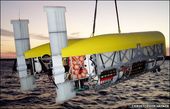The dive to 10,902m (6.8 miles) took place on 31 May, at the Challenger Deep in the Marianas Trench, located in the western Pacific Ocean.
This makes Nereus the deepest-diving vehicle currently in service and the first vehicle to explore the Marianas Trench since 1998.
The unmanned vehicle is remotely operated by pilots aboard a surface ship via a lightweight tether.
Its thin, fibre-optic tether to the research vessel Kilo Moana allows the submersible to make deep dives and be highly manoeuvrable.
Nereus can also be switched into a free-swimming, autonomous vehicle.
"With a robot like Nereus, we can now explore virtually anywhere in the ocean," said Andy Bowen, project manager and principal developer of the sub at the Woods Hole Oceanographic Institution (WHOI).
"The trenches are virtually unexplored, and I am absolutely certain Nereus will enable new discoveries. I believe it marks the start of a new era in ocean exploration."
The Challenger Deep is the deepest-known part of the ocean, and part of the Marianas Trench near the island of Guam in the west Pacific.
It is the deepest abyss on Earth at 11,000m-deep, more than 2km (1.2 miles) deeper than Mount Everest is high. At that depth, pressures reach 1,100 times those at the surface.

Payload capacity: 25kg
Maximum speed: 3 knots
Batteries: rechargeable lithium ion
In January 1960, Jacques Piccard and Don Walsh made the first and only manned voyage in a Swiss-built bathyscaphe known as the Trieste.
The vessel consisted of a 2m-diameter (6ft) steel sphere containing the crew suspended below a huge 15m-long (50ft) tank of petrol, designed to provide buoyancy.
During the nine-hour mission, the two men spent just 20 minutes on the ocean floor; enough time to measure the depth as 10,916m (35,813 ft).
No manned submersible has ever repeated the dive.
However, 35 years later, a Japanese remote-controlled vehicle called Kaiko returned, setting a depth record for unmanned exploration.
During its dive, the vehicle recorded a depth of 10,911m (35,797ft). It was also able to recover a sediment core and record pictures of life, including a sea cucumber, a worm and a shrimp.
Unlike Nereus, Kaiko had to rely on a cable connected to a ship at the surface for power and control.
The Japanese craft was lost in 2003 on an unrelated dive when a cable connecting it to its control ship snapped.
Currently, the deepest-rated vehicles are able to descend to 6,500m, allowing scientists access to 95% of the seafloor.
Nereus aims to change this to 100%, whilst also allowing scientists to survey a much larger area than vehicles like Kaiko.




Reader Comments
to our Newsletter